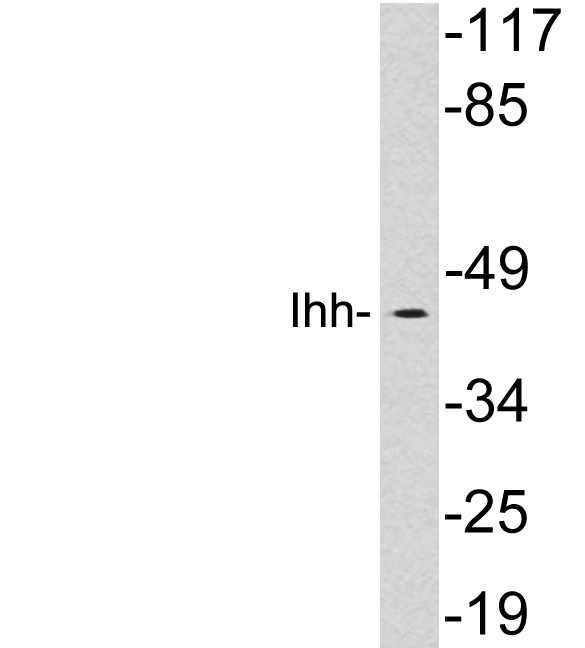Ihh Polyclonal Antibody
- Catalog No.:YT5023
- Applications:WB;ELISA
- Reactivity:Human;Mouse;Rat
- Target:
- Ihh
- Fields:
- >>Hedgehog signaling pathway;>>Proteoglycans in cancer
- Gene Name:
- IHH
- Protein Name:
- Indian hedgehog protein
- Human Gene Id:
- 3549
- Human Swiss Prot No:
- Q14623
- Mouse Gene Id:
- 16147
- Mouse Swiss Prot No:
- P97812
- Immunogen:
- The antiserum was produced against synthesized peptide derived from human Ihh. AA range:209-258
- Specificity:
- Ihh Polyclonal Antibody detects endogenous levels of Ihh protein.
- Formulation:
- Liquid in PBS containing 50% glycerol, 0.5% BSA and 0.02% sodium azide.
- Source:
- Polyclonal, Rabbit,IgG
- Dilution:
- WB 1:500 - 1:2000. ELISA: 1:20000. Not yet tested in other applications.
- Purification:
- The antibody was affinity-purified from rabbit antiserum by affinity-chromatography using epitope-specific immunogen.
- Concentration:
- 1 mg/ml
- Storage Stability:
- -15°C to -25°C/1 year(Do not lower than -25°C)
- Other Name:
- IHH;Indian hedgehog protein;IHH;HHG-2
- Observed Band(KD):
- 45kD
- Background:
- This gene encodes a member of the hedgehog family of proteins. The encoded preproprotein is proteolytically processed to generate multiple protein products, including an N-terminal fragment that is involved in signaling. Hedgehog family proteins are essential secreted signaling molecules that regulate a variety of developmental processes including growth, patterning and morphogenesis. The protein encoded by this gene specifically plays a role in bone growth and differentiation. Mutations in this gene are the cause of brachydactyly type A1, which is characterized by shortening or malformation of the fingers and toes. Mutations in this gene are also the cause of acrocapitofemoral dysplasia. [provided by RefSeq, Nov 2015],
- Function:
- disease:Defects in IHH are a cause of acrocapitofemoral dysplasia (ACFD) [MIM:607778]. ACFD is a disorder characterized by short stature of variable severity with postnatal onset. The most constant radiographic abnormalities are observed in the tubular bones of the hands and in the proximal part of the femur. Cone-shaped epiphyses or a similar epiphyseal configuration with premature epimetaphyseal fusion result in shortening of the skeletal components involved. Cone-shaped epiphyses were also present to a variable extent at the shoulders, knees, and ankles.,disease:Defects in IHH are the cause of brachydactyly type A1 (BDA1) [MIM:112500]. BDA1 is an autosomal dominant disorder characterized by middle phalanges of all the digits rudimentary or fused with the terminal phalanges. The proximal phalanges of the thumbs and big toes are short.,function:Intercellular signal essential for a varie
- Subcellular Location:
- [Indian hedgehog protein N-product]: Cell membrane ; Lipid-anchor ; Extracellular side . The N-terminal peptide remains associated with the cell surface. .; [Indian hedgehog protein C-product]: Secreted, extracellular space . The C-terminal peptide diffuses from the cell. .; Cell membrane .
- Expression:
- Expressed in embryonic lung, and in adult kidney and liver.
- June 19-2018
- WESTERN IMMUNOBLOTTING PROTOCOL
- June 19-2018
- IMMUNOHISTOCHEMISTRY-PARAFFIN PROTOCOL
- June 19-2018
- IMMUNOFLUORESCENCE PROTOCOL
- September 08-2020
- FLOW-CYTOMEYRT-PROTOCOL
- May 20-2022
- Cell-Based ELISA│解您多样本WB检测之困扰
- July 13-2018
- CELL-BASED-ELISA-PROTOCOL-FOR-ACETYL-PROTEIN
- July 13-2018
- CELL-BASED-ELISA-PROTOCOL-FOR-PHOSPHO-PROTEIN
- July 13-2018
- Antibody-FAQs
- Products Images

- Western Blot analysis of extracts from NIH-3T3 cells, using Ihh Polyclonal Antibody. Secondary antibody(catalog#:RS0002) was diluted at 1:20000

- Western blot analysis of lysates from HepG2 cells, using Ihh antibody.



